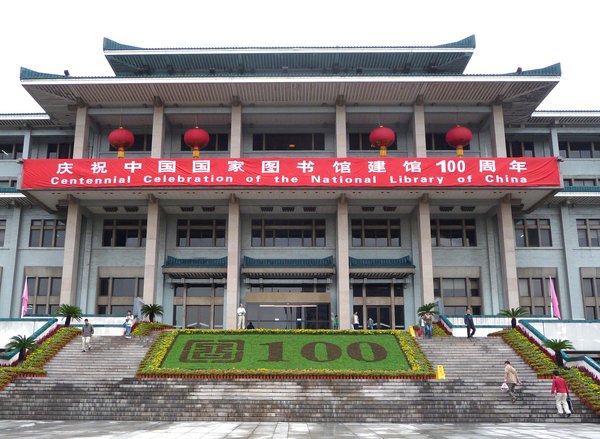The National Library of China (NLC) is celebrating its 100th birthday Wednesday. With the theme of "Pass on Civilization, Serve the Society" the centennial anniversary of the founding of NLC entails a series of activities such as exhibitions, academic conferences and story collections.
|

|
|
The National Library of China [CFP]
|
"We are commemorating the 100th birthday of NLC not merely for its extraordinary past, but more importantly for its inspiring present and bright future," Chen Li, vice library curator of NLC, told the Global Times.
During the past 100 years NLC has developed into a significant place of reading, learning and literature.
The founding of a national library was sanctified by Puyi, the last emperor of the Qing Dynasty (1644-1911), in September 1909. In the past century, the library has moved from its original temporary site at Guanghua Temple in Shichahai, to the old South School of the Imperial College, to No. 7 Wenjin Street near the Beihai Park and finally to its current site near Zizhuyuan Park near Xizhimen. It also has undergone several name changes, from the Capital Library to State-run Peking Library, then Beijing Library and now the National Library of China.
In its 100-year history, the library has also shared the ups and downs of the nation. Just before the July 7 Incident of 1937, in order to protect the nation's rare books, the then curator Yuan Tongli decided to transport them to the south of China. Yuan also employed this strategy in Shanghai. When the city fell to enemy occupation, Yuan risked his life to collect the most important rare books and send them to the US for microfilming. A total of 102 boxes were shipped, containing 30,000 books from 2,700 genres.
Nowadays, NLC covers a floor area of 250,000 square meters. It is the third largest national library in the world, next only to the Library of Congress in Washington DC and the Moscow National Library in Russia. NLC's collection ranks fifth in the world. Among others, NLC collects all of the published books within China. By 2008, NLC's overall collection totaled 26.31 million volumes and artifacts.
Its rare pieces include the Oracle Bones (inscriptions on animal bones and tortoise shells from the Shang Dynasty) and four specialized collections, namely, Dunhuang Manuscripts, Zhaocheng Tripitaka of the Jin Dynasty, Yongle Encyclopedia and Complete Library of the Four Branches of Literature.
Dunhuang Manuscripts was discovered in the Mogao Caves in Dunhuang and includes ancient editions of Chinese classics and Buddhism sutras. Zhaocheng Tripitaka of the Jin Dynasty was printed in the Jin Dynasty (1115-1234). The Buddhist canon is comprised of 6,980 volumes of text, using 168,000 woodblocks. Yongle Encyclopedia is a Chinese compilation commissioned by the Ming Dynasty (1368-1644) Emperor Yongle in 1403 and completed in 1408. It was then the world's largest known general encyclopedia and one of the earliest. Complete Library of the Four Branches of Literature was compiled between 1773 and 1782, it is a collection and annotation of over 10,000 manuscripts from the imperial collections and other libraries. The Complete Library was bound into 36,381 volumes with more than 79,000 chapters, comprising about 2.3 million pages and approximately 800 million Chinese characters.